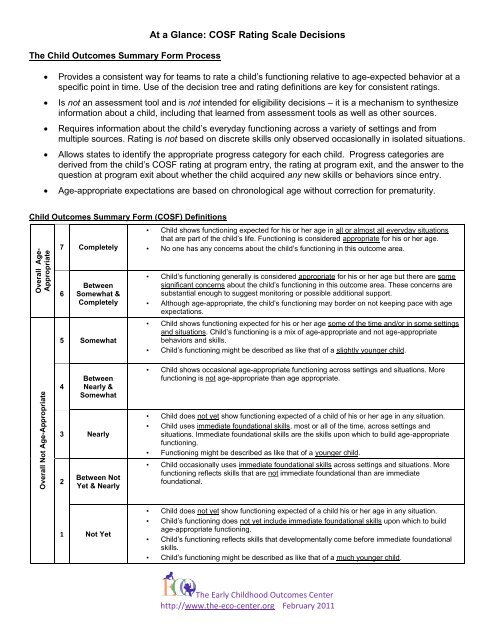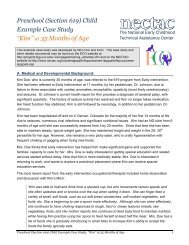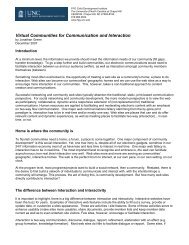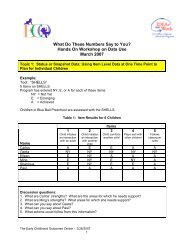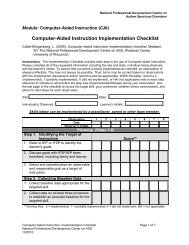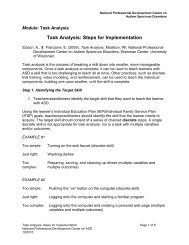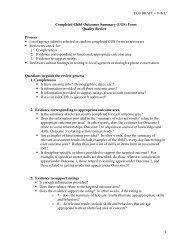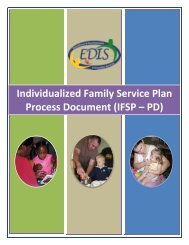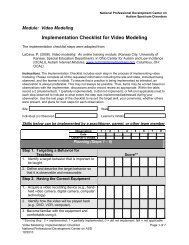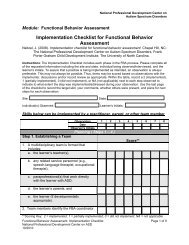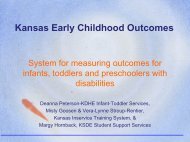At a Glance: COSF Rating Scale Decisions - FPG Child ...
At a Glance: COSF Rating Scale Decisions - FPG Child ...
At a Glance: COSF Rating Scale Decisions - FPG Child ...
You also want an ePaper? Increase the reach of your titles
YUMPU automatically turns print PDFs into web optimized ePapers that Google loves.
Overall Age-AppropriateOverall Not Age-AppropriateThe <strong>Child</strong> Outcomes Summary Form Process<strong>At</strong> a <strong>Glance</strong>: <strong>COSF</strong> <strong>Rating</strong> <strong>Scale</strong> <strong>Decisions</strong>Provides a consistent way for teams to rate a child’s functioning relative to age-expected behavior at aspecific point in time. Use of the decision tree and rating definitions are key for consistent ratings.Is not an assessment tool and is not intended for eligibility decisions – it is a mechanism to synthesizeinformation about a child, including that learned from assessment tools as well as other sources.Requires information about the child’s everyday functioning across a variety of settings and frommultiple sources. <strong>Rating</strong> is not based on discrete skills only observed occasionally in isolated situations.Allows states to identify the appropriate progress category for each child. Progress categories arederived from the child’s <strong>COSF</strong> rating at program entry, the rating at program exit, and the answer to thequestion at program exit about whether the child acquired any new skills or behaviors since entry.Age-appropriate expectations are based on chronological age without correction for prematurity.<strong>Child</strong> Outcomes Summary Form (<strong>COSF</strong>) Definitions7 Completely• <strong>Child</strong> shows functioning expected for his or her age in all or almost all everyday situationsthat are part of the child’s life. Functioning is considered appropriate for his or her age.• No one has any concerns about the child’s functioning in this outcome area.6BetweenSomewhat &Completely5 Somewhat• <strong>Child</strong>’s functioning generally is considered appropriate for his or her age but there are somesignificant concerns about the child’s functioning in this outcome area. These concerns aresubstantial enough to suggest monitoring or possible additional support.• Although age-appropriate, the child’s functioning may border on not keeping pace with ageexpectations.• <strong>Child</strong> shows functioning expected for his or her age some of the time and/or in some settingsand situations. <strong>Child</strong>’s functioning is a mix of age-appropriate and not age-appropriatebehaviors and skills.• <strong>Child</strong>’s functioning might be described as like that of a slightly younger child.4BetweenNearly &Somewhat• <strong>Child</strong> shows occasional age-appropriate functioning across settings and situations. Morefunctioning is not age-appropriate than age appropriate.3 Nearly2Between NotYet & Nearly• <strong>Child</strong> does not yet show functioning expected of a child of his or her age in any situation.• <strong>Child</strong> uses immediate foundational skills, most or all of the time, across settings andsituations. Immediate foundational skills are the skills upon which to build age-appropriatefunctioning.• Functioning might be described as like that of a younger child.• <strong>Child</strong> occasionally uses immediate foundational skills across settings and situations. Morefunctioning reflects skills that are not immediate foundational than are immediatefoundational.1 Not Yet• <strong>Child</strong> does not yet show functioning expected of a child his or her age in any situation.• <strong>Child</strong>’s functioning does not yet include immediate foundational skills upon which to buildage-appropriate functioning.• <strong>Child</strong>’s functioning reflects skills that developmentally come before immediate foundationalskills.• <strong>Child</strong>’s functioning might be described as like that of a much younger child.The Early <strong>Child</strong>hood Outcomes Centerhttp://www.the-eco-center.org February 2011
No Age Expected Skills and a Decreasing Degree ofImmediate Foundational SkillsAge Expected SkillsDecreasing egree of Age-Expected Skills<strong>At</strong> a <strong>Glance</strong>: <strong>COSF</strong> <strong>Rating</strong> <strong>Scale</strong> <strong>Decisions</strong><strong>COSF</strong> <strong>Rating</strong> <strong>Scale</strong> Descriptor<strong>COSF</strong> <strong>Rating</strong>7 CompletelyAEIFFSample Statements• Relative to other children Calvin’s age, he has all of the skills that we would expectof a child his age in the area of (outcome [e.g., taking action to meet needs]).• Calvin has a good mix of age expected skills in the area of (outcome).65 SomewhatAEIFFAEIFF• Relative to same age peers, Calvin has the skills that we would expect of his agein regard to (outcome); however, there are concerns with how he (functional areathat is of concern/quality of ability/lacking skill).• Aside from the concern regarding Calvin’s _____ he is demonstrating skillsexpected of a child his age in the area of (outcome).• For an # month old child, Calvin has many skills expected of his age but he alsodemonstrates some skills slightly below what is expected at this age in the areaof (outcome).• Relative to same age peers, Calvin shows many age expected skills, but continuesto show some functioning that might be described like that of a slightly youngerchild in the area of (outcome).• Calvin is somewhat where we would expect him to be at this age. This means thatCalvin has many skills we would expect at this age in regard to (outcome), but hedoes not yet have all of the age expected skills (it is possible to identify a few ofthe functional skills the child is lacking to be age appropriate).43 Nearly21 Not YetAEIFFAEIFFAEIFFAEIFF• <strong>At</strong> # months Calvin, shows occasional use of some age expected skills, but moreof his skills are not yet age expected in the area of (outcome).• <strong>At</strong> # months Calvin, shows occasional use of some age expected skills, but hasmore skills that are younger than those expected for a child his age in the areaof (outcome).• Calvin has a few of the skills we would expect in regard to (outcome), but he showsmore skills that are not age appropriate.• Relative to same age peers, Calvin is not yet using skills expected of his age. Hedoes however use many important immediate foundational skills to build upon inthe area of (outcome).• In the area of (outcome), Calvin is nearly displaying age-expected skills. Thismeans that he does not yet have the skills we would expect of a child his age. Hehas the immediate foundational skills that are the building blocks to achieveage-appropriate skills. (It is possible to include a few functional skills as examples).• <strong>At</strong> # months Calvin, shows occasional use of some immediate foundationalskills that will help him move toward age-appropriate skills. More of his functioningdisplays earlier skills in the area of (outcome).• Relative to same age peers, Calvin is showing some immediate foundationalskills, but has more skills that developmentally come in earlier in the area of(outcome).• For a # month old little boy, Calvin occasionally uses immediate foundationalskills but has a greater mix of earlier skills that he uses in the area of (outcome).• Overall in this outcome area, Calvin is just beginning to show some immediatefoundational skills which will help him to work toward age appropriate skills.• Relative to same age peers, Calvin has the very early skills in the area of(outcome). This means that Calvin has the skills we would expect of a muchyounger child in this outcome area.• For a # month old little boy, Calvin’s shows early skills in the outcome area. He doesnot yet show age expected skills or the skills that come right before those.Note. Adapted by the ECO Center from materials developed by Naomi Younggren (Feb. 2010) Department of Defense for EDIS.The Early <strong>Child</strong>hood Outcomes Centerhttp://www.the-eco-center.org February 2011
Decision Tree for Summary <strong>Rating</strong> DiscussionsDoes the child ever function in ways that would be considered ageappropriatewith regard to this outcome?No (consider rating 1-3) Yes (consider rating 4-7)Does the child use any immediate foundational skills relatedto this outcome upon which to build age-appropriatefunctioning across settings and situations?Is the child’s functioning age-appropriate across all oralmost all settings and situations?NoYesNoYesTo what extent is the child usingimmediate foundational skills acrosssettings and situations?To what extent is the child’sfunctioning age-appropriateacross settings and situations?Does anyone haveconcerns about the child’sfunctioning with regard tothe outcome area?Uses skills thatare not yetimmediatefoundationalOccasional use ofimmediatefoundational skillsUses immediatefoundational skills mostor all of the time acrosssettings and situationsOccasionaluse of ageappropriateskills; morebehavior thatis not ageappropriateUses a mix ofageappropriateand not ageappropriatebehaviors andskills acrosssettings andsituationsYesNo<strong>Rating</strong> =Not YetBetweenNot Yet &Emerging<strong>Rating</strong> =NearlyBetweenNearly &Somewhat<strong>Rating</strong> =SomewhatBetweenSomewhat &Completely<strong>Rating</strong> =Completely


